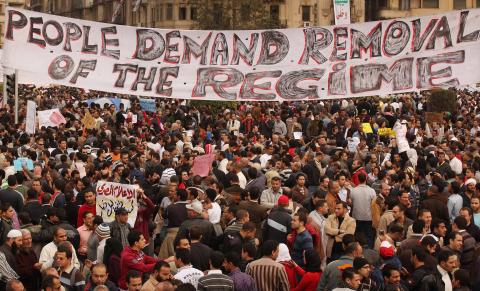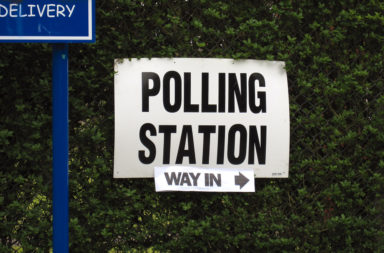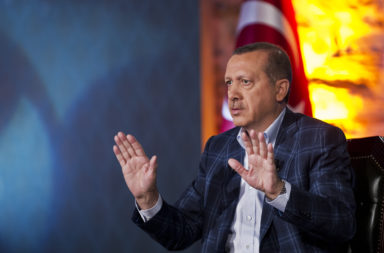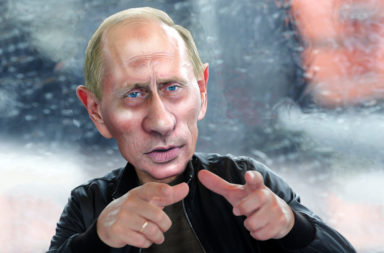No analysis of power dynamics in the Middle East and North Africa region can ignore the necessity of a regional order. Understanding the causes of today’s regional vacuum requires the study of why the previous regional order crumbled in the first place and the consequences of this failure, including the popular uprisings across the Arab world.
We can only answer the question of who holds power in the region once this question is placed within the debate over the regional order in the Middle East, which I prefer to call the Sharq region, given the resonance of this word for the people – be they Arabs, Iranians, Kurds or Turks – who live there.
Roots of the old regional order’s demise
From two Iraqi wars to the war on terror, to waves of uprisings in Arab countries, events have prepared the ground for the demise of the old Arab order. Putting aside external factors, the decline was gradual until the Arab uprisings – whose structural foundations had long been present – speeded up the process of decay.
The death of the old order does not mean that the old guard is no longer active in the region. On the contrary, authoritarian regimes and police states of all stripes are still the dominant modes of governance in the region.
But something more fundamental has changed. The political mindset that underpinned this old order has collapsed. The prevailing political psychology across the region now refuses to accept rule by these relics the past. This makes the foundation of these authoritarian regimes shakier than ever before.
But the old order has yet to give way to a new one. We are passing through an interregnum filled with uncertainties and challenges. Putting aside the first couple of decades following the end of colonialism, during which anti-colonial movements enjoyed wide support, the Arab state system has always suffered a severe legitimacy deficit.
In the Middle East, the idea of the state was not premised on a state of its citizens, responsive to their wishes and needs; instead, the state and the people were set against each other. Such a binary state-society division formed the crux of the legitimacy crisis. This lack of public legitimacy led states to seek to survive through forming international alliances and building heavy security apparatuses.
In addition to the West’s historical involvement, colonial legacy and power projections in the region, the legitimacy deficits of local elites have further paved the way for the West to play a harmful role in the region, which has reduced these elites to mere players in a western-centric state system.
This has culminated in further fragmentation of the region, a deepening of the legitimacy crises within states and further wedges between these states and their respective societies.
State failure also contributed to the demise of the previous order. The state system was not merely illegitimate in the eyes of the people; rulers were also inept and incapable of delivering basic demands, whether for security or economy stability.
From Yemen to Iraq, and Syria to Egypt, the state has become the instrument of a narrow clique, formed by identity, ideology or particular interests. The more these elites have reduced themselves to representatives of certain traditional or parochial identities, the more political conceptualizations of citizenship have crumbled.
This has enabled other traditional identities – sectarian, ethnic or religious – to replace political identities, and become the primary sources of allegiance and loyalty.
Likewise, the state equalled the regime, which equalled the ruling elite or party. This equation was in place for Syria, Egypt, Libya and Iraq, making the state system fragile.
But this equation also shows the way forward in highlighting what needs to be avoided. If the state embodies the interests of a party, a ruling elite, a certain ideology or a family, then a change in any of these groups will have a direct impact on the state structure itself.
While the old order may be on its deathbed, the new one is not yet in sight. This transitional period appears likely to last for some time before the ground is laid for a new order. In the meantime, locating and denoting the emerging features of this period will be important to understand the nature of the regional order yet to be born.
The interregnum: emerging trends
The features of the present interregnum are closely related to the evolution of the Arab uprisings.
First, these uprisings came as a result of socio-political and socio-economic struggles. At their outset, they were defined by political demands. Yet the longer they lasted and the more they became militarized, the more they changed from being a struggle to meet political demands into one of competing political identities. This sectarian/ethnic dimension lessened the uprisings’ inclusivity and fragmented the original alliances around political demands.
Second, the Arab uprisings were born out of a domestic context. Yet as they evolved they were affected and informed more by regional and international power plays. Particularly since late 2012 and early 2013, the evolution of the Arab Spring has been shaped primarily by regional and international power struggles. The Syrian imbroglio is the clearest example of this trend.
Third, the consequences of these uprisings have eclipsed their root causes. The militarization of the Arab uprisings in Syria, Yemen, and Libya produced many damaging external effects, ranging from the flood of refugees, to radicalism of all flavours, the most important of which is the self-styled Islamic State group. This has changed the focus of the debate. No longer are we discussing the underlying causes behind these uprisings. Instead, we have spent an excessive amount of time, energy and resources on the consequences of an aborted process of change.
This change of focus has extended the lifespan of dictatorial regimes and in turn has entrenched the underlying causes of the Arab uprisings.
 Fourth, militias and zones of influence constitute the new reality of the region. From Libya to Syria to Yemen, the transformation of these Arab uprisings into civil wars has produced two primary outcomes: militias based on identity or interests dominate the security and political scenes. It is unlikely that these militias will be eliminated in the short term. Most likely, in the future some balance between elimination and integration will need to be struck.
Fourth, militias and zones of influence constitute the new reality of the region. From Libya to Syria to Yemen, the transformation of these Arab uprisings into civil wars has produced two primary outcomes: militias based on identity or interests dominate the security and political scenes. It is unlikely that these militias will be eliminated in the short term. Most likely, in the future some balance between elimination and integration will need to be struck.
As a corollary, zones of influence have emerged. Again, the clearest example is Syria. The regime, the opposition, the Kurdish Democratic Union party (PYD) and the self-styled Islamic State form four rough zones of influence. Such zones also correspond to the calculations and power struggles of regional and international powers. These two trends will have implications for any regional order established in the post-crisis period.
A new regional order
The factors behind the demise of the old order and the features of the current interregnum point to the issues that a prospective new form of regional order will need to address.
First, as regional conflicts have acquired strong identity dimensions, any prospective regional order will have to deal with this question. A post-crisis social contract needs to satisfy people’s identity demands, be they ethnic or sectarian.
Second, neither secession nor centralization should be the operational principle. The dynamism of identity demands and the emergence of zones of influence and internal borders in the crisis-ridden countries make the previous model of a highly centralized state system untenable. Secessionism is no solution either, and will only sow the seeds of further calamity for the region.
Given the mix of demographic maps, and the economic, political and social interdependency of the different components of the countries concerned, it is not easy to implement clear-cut secessionist projects. It is not bad borders, it is bad politics that has aggravated grievances.
A social contract that can guarantee all the rights and liberties of identity groups, both individually and collectively, coupled with power devolution based on administrative units instead of identity maps, transferring power from the centre to the regions, appears to be a more workable formula than secessionist or centralist models.
Third, the emergence of legitimate and representative political elites is essential for the success of a new regional order. This is particularly important when dealing with crisis of Sunni marginalization, particularly in Iraq and Syria.
Fourth, a region-wide ideological reconciliation of Islamists with secularists/nationalists, and identity-based reconciliation between Sunni and Shia and between Kurds, Arabs, Turks and Iranians, is another necessary ingredient.
Fifth, a balance of power needs to be established among the primary players, Iran, Turkey and Saudi Arabia. On this point, the glaring gap between the Iranian and Saudi mindsets is inimical to the emergence of any regional order.
While Iran believes that it is winning in the region, which encourages further expansionist policies, Saudi Arabia feels that it is losing ground to Iran, which encourages it to engage in policies of defensive resistance. This perception gap is destructive of the necessary regional consensus.
Here, the West in particular has often misunderstood or dismissed regional grievances in regard of Iran.
For the West, the Iranian question was reduced to containing its nuclear programme. Paradoxically, Iran was content with this: the more Iran was reduced to the nuclear file, the more its contentious regional policy went unseen by the West.
In contrast, for the powers in the region, the Iranian question was less about its nuclear aspirations and more about its regional policies.
From Syria to Yemen, from Lebanon to Iraq and to the Gulf, Iran’s expansionist policies and militia armies have generated anxiety. In fact, if the curbing of Iran’s nuclear programme allows the West to acknowledge the deleterious impact of Iran’s regional policy, then it is a welcome development. If the new US administration decides to make an issue of Iran’s regional adventures, then it is likely to find many regional allies.
The way forward
The era of regional dominance – by the two superpowers, the US and USSR, and in the aftermath of the Cold War by the US alone – is over. Any drive for or pretension to hegemonic dominance is bound to fail.
As the era of authoritarian stability is over, extra-regional powers need to think who will form the primary constituency of their foreign policy.
This decision is more urgent than ever. During the authoritarian stability era, answering this question was relatively easy. The outside powers had client states, and the nature of their relationship was one of asymmetric dependency. Even in this context, the strata of society most important for the external powers were foreign and security policy elites, particularly military establishments, not society at large.
The era of easy choices is over. Now, there is a much more complicated picture. These extra-regional powers, starting with the US, are not only required to choose allies among the states of the region, but also sometimes must make a choice between states and society. This is particularly true when the state embodies no more than the interests and visions of a minority group, one segment of society or just particular individuals.
In this case, the demands of ‘the state’ and the interests of society are irreconcilable and set against each other. Extra-regional powers must respond to the following questions: who should be the primary constituency of our foreign policy in the region or in the country? How effective will this constituency be in ensuring our interests, and how sustainable? Here the existence of a new political psychology among the people of the region comes into the equation, making an alliance with illegitimate elites a costly, untenable affair. Investing in authoritarian regimes will not bring stability, security, or prosperity to the region. Any alliance with them should proceed on the understanding that the underlying causes of the Arab uprising remain unaddressed and thus all the authoritarian regimes in the region are fragile, with uncertain prospects.
The US should, therefore, ally itself with the people rather than out-of-date regimes trying to cling on to power. It should also know that in a contest to acquire the loyalty of such authoritarian regimes, it will face an uphill battle, given that their Russian and Chinese competitors, reflecting the values underpinning their own domestic politics, will be more at ease in supporting authoritarian regimes.
While the US-centric regional order, and particularly the regional security architecture, is being undone, this does not mean that any other regional or international actor will necessarily supplant the United States.
Russia and even China can be players in regional politics and to some extent Russia is a major international player, with significant implications for regional hotspots – Syria being the most glaring example. But Russia lacks the economic, political, military, ideological and cultural elements that it needs to play the role of a hegemon underpinning the regional order.
The record of Russian involvement in the region indicates that it does not have a region-wide policy. It wants a solid but limited regional presence. The political and economic burden of playing the hegemon in a volatile region is too high for Russia.
For this reason, Russia has a selective engagement policy in the region. While it is deeply involved in Syria, it consciously avoids the same level of involvement in other crises.
It seems that for Russia the region is not an end in itself. Instead, it is a means for other ends – to boost its global status or to use as a bargaining chip for leverage in the Baltic or Eastern Europe, to curb NATO’s eastward expansion and to avoid popular revolts on its own soil.
The era of an ever-more penetrated Middle East and North Africa region being dominated by a single power is over. Even a repeat of the Cold War-era ‘zones of influence’ policy by Russia and the US is now unattainable. It is highly likely that we will see major international powers having only a selective engagement policy in the region. In the short run, this will bode ill for the creation of a regional order, as we will see the atomization of the regional order, and even national order, continue unabated. In the long run, however, it may be a blessing for the region’s people, as it allows them to be the agents of their own destiny and stakeholders in the ownership of the security architecture.
The picture as regards regional powers is no different. Despite fierce regional rivalries, the region will not be dominated by any single actor. That is why the options are simple: to have a collective political order and security architecture, or have none at all. Any such regional order has to address the trends that have been generated by the current interregnum in the region.
Finally, what is happening in the Middle East is not going to reach a conclusion in a few years. Instead, it is likely to be a generational process, which requires long-term planning and commitment on everyone’s part, both within and outside the region. The current zero-sum power struggles of the region create many losers but no winner.
All the gains and losses are conjectural and subject to change. In this context, first recognizing the new currents shaping
regional societies and then aligning your foreign policy with these trends seems to be a better long-term investment for interested powers.
In this respect, the disappearance of the concepts of democracy, good governance, human rights and human dignity is not only counter to all the declared values and norms of the West, but inimical to their interests.
Today’s regional upheaval clearly illustrates that the previous authoritarian regional status quo was a recipe for disaster. Neither the region’s future, nor any conceivable regional order, can be based on this power structure.
A functional regional order and mutually fruitful relations between the region and the West will be attained only when the region achieves the ideals of its people: democratic stability.
This article was first published at Chatham House’s The World Today magazine.




